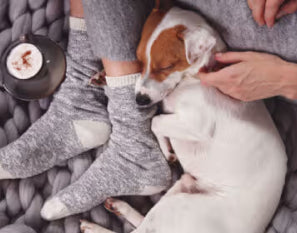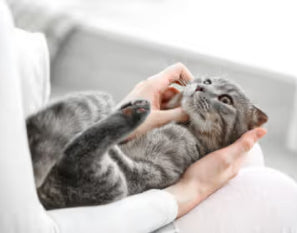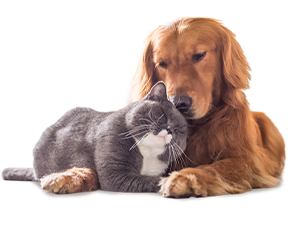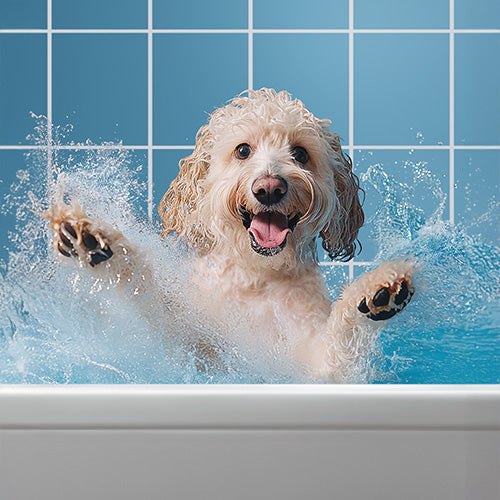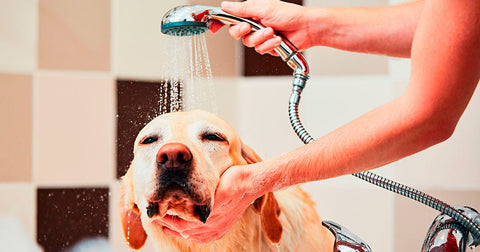
Wenn die Haut der Katze ihre Schutzfunktion verliert
Die Haut ist das größte Organ der Katze, sie spielt eine zentrale Rolle für Gesundheit und Wohlbefinden und kann wichtige Hinweise auf Erkrankungen der inneren Organe liefern. Sofern deine Katze nicht zu einer haarlosen Rasse gehört, ist ihre Haut mit Fell bedeckt, was es oftmals schwer macht, Hautveränderungen frühzeitig zu erkennen. Wenn dir Veränderungen an Haut oder Fell deiner Katze auffallen, kann dies auf ein gesundheitlichen Problem hinweisen und sollte tierärztlich abgeklärt werden.
Funktionen der Hautbarriere
Die Haut ist das größte Organ der Katze. Sie schützt vor Verletzungen und Krankheiten und schädlichen Einflüssen aus der Umwelt und übernimmt zahlreiche weitere wichtige Funktionen für die Gesundheit und das Wohlbefinden der Katze:
- Schutzfunktion: Schützt die inneren Organe vor Verletzungen.
- Abwehr von Bakterien, Viren, Keimen etc.: Schützt den Körper vor Infektionen.
- Temperaturregulierung: wichtige Rolle bei der Anpassung der Körpertemperatur.
- UV-Schutz: Schützt vor gefährlichen UV-Strahlen.
- Flüssigkeitsversorgung: Verhindert Dehydrierung, indem sie Feuchtigkeit speichert.
- Sensorische Funktion: Zuständig für das Empfinden von Schmerz, Temperatur, Juckreiz etc.
Was passiert, wenn die Hautbarriere beschädigt wird?
Wie du siehst, spielt die Hautbarriere für die Gesundheit deiner Katze eine entscheidende Rolle, sie kann jedoch aus verschiedenen Gründen wie einer genetischen Veranlagung, Verletzungen oder Infektionen geschwächt werden. Bei Allergien kann z.B. eine genetische Veranlagung zu einer „undichten“ Hautbarriere führen, durch welche Allergene eindringen können. Dies führt zu Juckreiz, die Katze beginnt sich stark zu kratzen und beschädigt die Haut hierdurch immer weiter. Dieser Teufelskreis wird auch als „Juck-Kratz-Zyklus” bezeichnet.
Ist die Hautbarriere einmal beschädigt, können Bakterien und Hefepilze sehr leicht in die Haut eindringen und Sekundärinfektionen verursachen. Je nach Ausmaß der Schädigung kann dies nur an einzelnen Körperstellen oder auch am gesamten Körper auftreten. Schuppen, entzündete und gerötete Haustellen, Haarausfall und starker Juckreiz sind weitere Anzeichen dafür, dass deine Katze unter einer Hauterkrankung leidet.
Ist die Fellpflege meiner Katze normal?
Katzen sind sehr reinliche Tiere und verbringen normalerweise viel Zeit damit, ihr Fell zu pflegen und Schmutz und lose Haare zu entfernen. Hört deine Katze plötzlich auf, ihre Fell zu reinigen, kann dies ein Anzeichen dafür sein, dass sie sich unwohl fühlt oder sogar krank ist.
Die Zeit, die Katzen jeden Tag mit der Fellpflege verbringen, kann je nach Rasse, Alter und den Lebensumständen (Hauskatze oder Freigänger) variieren - grundsätzlich ist es jedoch normal, dass Katzen einen erheblichen Teil des Tages darauf verwenden ihr Fell zu reinigen. Hierzu gehört das Belecken und Beknabbern von Fell und Haut sowie das Reiben der Vorderpfoten über den Kopf.
Wenn Fellpflege übermäßig wird
Umgekehrt kann die Fellpflege bei Katzen auch übermäßig werden. In diesem Fall verbringen Katzen täglich immer mehr Zeit damit, sich zu putzen und vernachlässigen oftmals andere Aktivitäten. Eine exzessive Fellpflege kann schnell zu Haarausfall führen, was meist vom Besitzer als erstes Alarmzeichen wahrgenommen wird. Sobald die Ursache behoben ist, wächst das Fell jedoch in der Regel wieder normal nach.
Warum betreibt meine Katze übermäßige Fellpflege?
In den meisten Fällen ist übermäßige Fellpflege bei Katzen eine Reaktion auf Schmerzen oder Juckreiz, sie kann aber auch im Zusammenhang mit Stress auftreten. Fast immer kommt es dabei zu starkem Haarausfall, welcher überall am Körper auftreten kann, sich jedoch am häufigsten am Bauch, zwischen den Vorder- oder Hinterbeinen oder an den Flanken zeigt. Es können zudem auch weitere Anzeichen wie Hautausschlag, Schuppen und Hautläsionen auftreten.
Es gibt zahlreiche mögliche Ursachen für eine übermäßige Fellpflege bei Katzen, dazu gehören unter anderem Allergien, Parasiten wie Flöhe oder Milben, Schmerzen wie Arthritis, Stress und Verhaltensprobleme.
Solltest du Haarausfall oder Hautveränderungen bei deiner Samtpfote bemerken, ist es daher wichtig, sie zügig beim Tierarzt vorzustellen, um die Ursache abzuklären und mögliche Grunderkrankungen auszuschließen. Je früher die Behandlung beginnt, desto leichter lassen sich die meisten Hauterkrankungen behandeln.
Allergien
Katzen können Allergien gegen eine Vielzahl von Substanzen aus Umwelt oder Nahrungsmitteln entwickeln. Einige Tiere leiden unter mehreren Allergien, was es schwieriger macht, den Auslöser zu identifizieren und das Allergen, welches Schübe verursacht, vollständig zu vermeiden. Allergien können mit starkem Juckreiz einhergehen und Haarausfall, Hautrötungen und sekundäre Hautinfektionen verursachen. Häufig ist eine lebenslange tierärztliche Behandlung erforderlich, um die Symptome der Hauterkrankung zu behandeln. Unsere DOUXO® S3 CALM-Produktreihe eignet sich perfekt für die langfristige Anwendung. Indem es die Barrierefunktion der Haut wiederherstellt, hilft es, Schübe zu reduzieren und Symptome zu lindern.
Parasiten
Flohbisse lösen oftmals Hauterkrankungen bei Katzen aus. Einige Tiere leiden unter einer Flohspeichelallergie und entwickeln in Folge eines Bisses eine schwere Hautreaktion mit Juckreiz und Rötungen. Neben der tierärztlichen Behandlung sorgen auch die Produkte unserer DOUXO® S3 CALM-Reihe für Linderung bei juckender Haut und fördern die Hautregeneration.
Schmerzen
Arthritis ist eine schmerzhafte Erkrankung, die zu Rücken- und Gelenkschmerzen führen und die Katze bei ihrer täglichen Körperpflege beeinträchtigt. Putzt sich die Katze seltener als früher und zeigt zudem Schuppen und ein schmutziges Fell, kann dies darauf hinweisen, dass sie an Arthritis leidet. Neben einer tierärztlichen Behandlung lassen sich die Haut- und Fellprobleme sehr gut mit DOUXO® S3 SEB in den Griff bekommen. Die Produkte der DOUXO® S3 SEB-Reihe regulieren die Talg- und Schuppenproduktion der Haut, stärken die Hautbarriere und wirken effektiv gegen unangenehme Gerüche. Für Katzen die nicht gerne gebadet werden, bietet sich besonders unser praktisches Mousse an.
Psychogene Alopezie
Katzen pflegen ihr Fell, um sich in Stresssituationen zu beruhigen. Bei einigen Katzen kann dies jedoch zu einem erlernten Verhalten werden und dazu führen, dass sie in ihrem täglichen Leben exzessive Fellpflege betreiben. Hauskatzen haben ein höheres Risiko, an psychogener Alopezie zu erkranken, insbesondere wenn sie nur wenige Interaktionen mit anderen Katzen haben. Bevor jedoch eine Diagnose gestellt werden kann, müssen zunächst andere Erkrankungen ausgeschlossen werden.
Was kann ich tun, um meiner Katze zu helfen?
Eine ganze Menge! Ganz wichtig ist zunächst eine gute Vorsorge: Nur du siehst deine Katze jeden Tag und kannst kleinste Veränderungen frühzeitig bemerken. Als Faustregel gilt, dass gesunde Katzen nicht mehr als eine Stunde pro Tag mit dem Belecken des Fells und nicht mehr als eine Minute pro Tag mit Kratzen verbringen sollten. Leckt oder kratzt deine Katze sich häufiger, solltest du einen Tierarzt aufsuchen.
Hautprobleme können sich leider sehr schnell entwickeln und für die Katze sehr schmerzhaft sein. Warte daher nicht, bis deine Katze gerötete, wunde und aufgekratzte Hautstellen entwickelt, sondern stelle sie einem Tierarzt vor, sobald sich erste Hautveränderungen zeigen.
Je nach Schweregrad kann es einige Zeit dauern, bis Hautkrankheiten vollständig geheilt sind und oftmals ist eine langfristige, angepasste Hautpflege nötig. Hierfür eignet sich unsere klinisch getestete und von Tierärzten empfohlene DOUXO® S3 Hautpflegeserie - sie unterstützt die Haut bei der Regeneration und stärkt die Hautbarriere. DOUXO® S3 CALM bietet sofortige Linderung bei Juckreiz, während DOUXO® S3 PYO hilft, das mikrobielle Gleichgewicht wiederherzustellen, und DOUXO® S3 SEB den die Talgproduktion reguliert.







